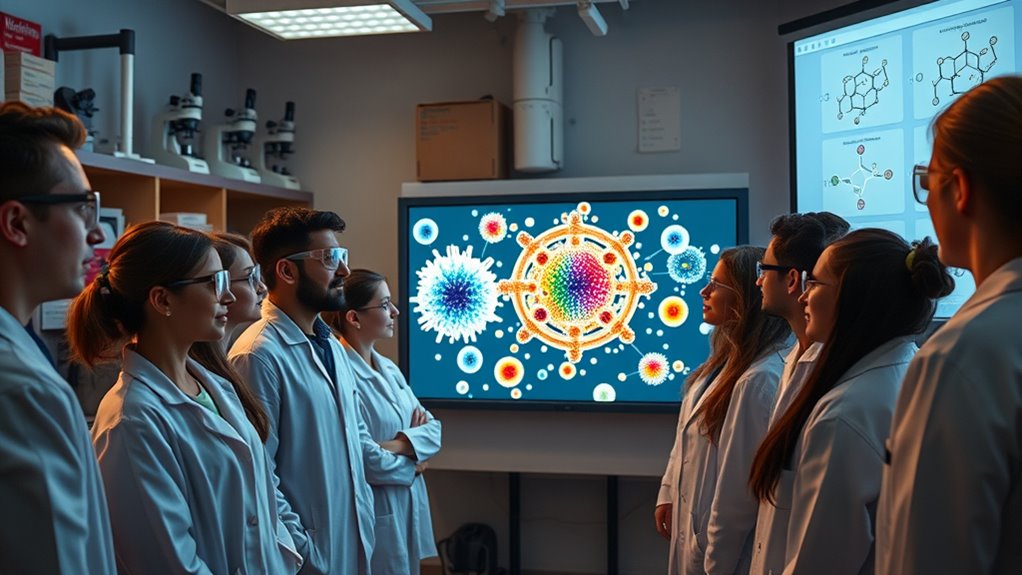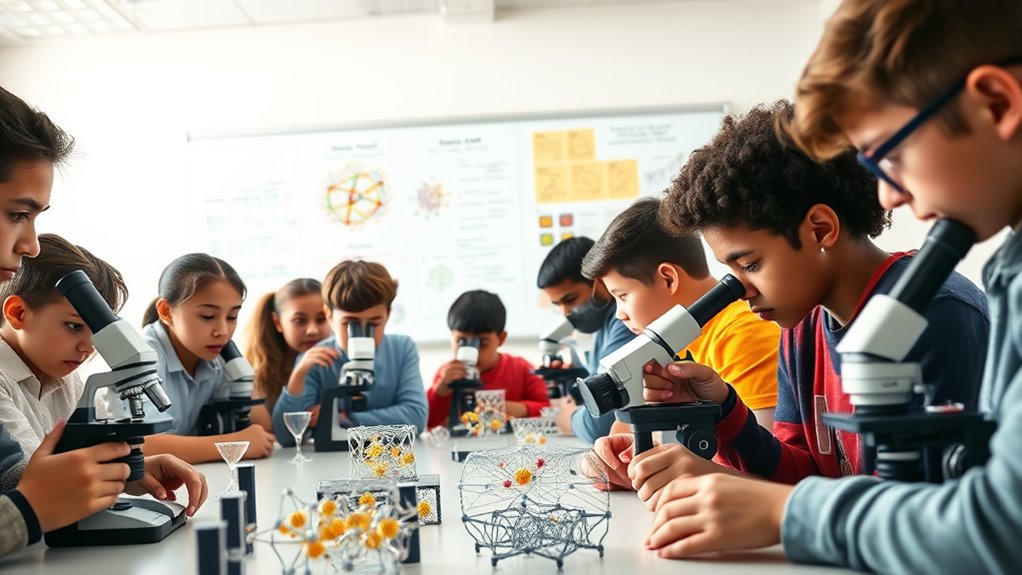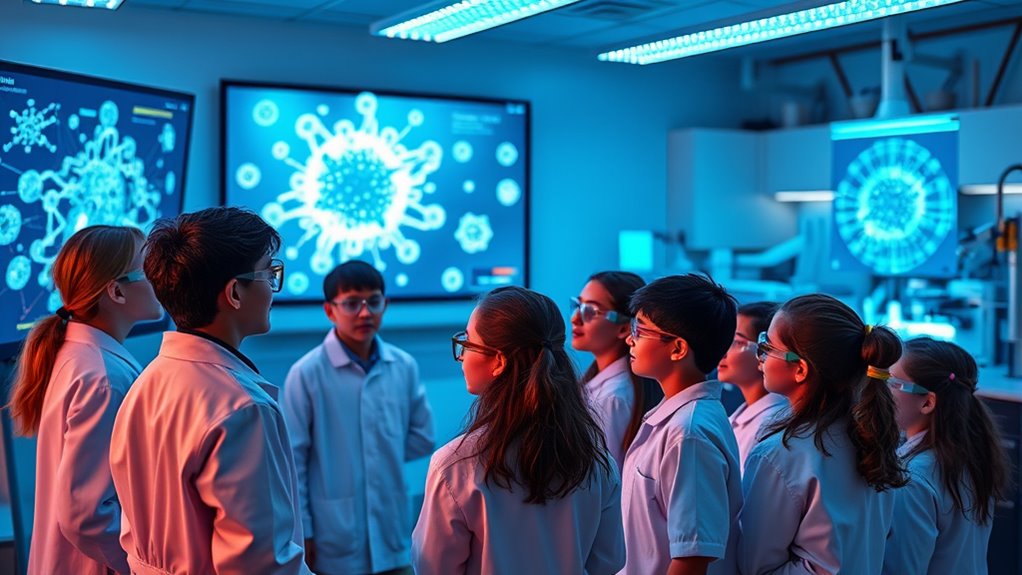To educate the next generation of nanotechnologists, focus on foundational science and surface chemistry, while integrating interdisciplinary approaches from physics, chemistry, biology, and engineering. Combine hands-on lab work with simulations, emphasizing ethical research and safety. Develop critical thinking and problem-solving skills, promote collaboration, and stay current with emerging trends like 2D materials and quantum dots. Engaging students through real-world applications and active learning prepares them for future innovations—if you explore further, you’ll discover more strategies to inspire their success.
Key Takeaways
- Incorporate interdisciplinary coursework merging physics, chemistry, biology, and engineering to foster holistic understanding and innovation.
- Utilize hands-on experiments, simulations, and real-world projects to develop practical skills and critical thinking.
- Embed emerging trends like quantum dots and 2D materials into curricula to keep pace with technological advancements.
- Promote ethical research practices and safety protocols to ensure responsible development in nanotechnology.
- Foster collaboration, communication, and problem-solving skills through active learning, industry partnerships, and early research opportunities.
Foundations of Nanoscience and Nanotechnology

Understanding the foundations of nanoscience and nanotechnology is essential for anyone aspiring to work in this rapidly evolving field. You need to grasp how matter behaves differently at the nanoscale, where quantum effects and surface phenomena dominate. This knowledge helps you understand how to manipulate materials at the atomic and molecular levels, enabling innovations in electronics, medicine, and energy. Core concepts include the structure and properties of nanomaterials, techniques for their synthesis, and characterization methods. You’ll also explore how size, shape, and surface chemistry influence behavior. Developing a solid understanding of these principles allows you to design new nanostructures and applications. Additionally, understanding surface chemistry is vital because it governs interactions at the nanoscale and impacts material stability and functionality. Without this foundation, advancing in nanotechnology becomes difficult, as it’s the basis for all further learning and innovation in the field.
Integrating Interdisciplinary Learning Approaches

To effectively prepare for a career in nanotechnology, you need to embrace interdisciplinary learning approaches that integrate knowledge from physics, chemistry, biology, and engineering. This approach helps you develop a holistic understanding of complex nanosystems and solves real-world problems. By combining theories and techniques across disciplines, you’ll learn to innovate and adapt quickly. Consider exploring:
Embrace interdisciplinary learning to master nanotechnology and solve real-world nanosystems challenges.
- Cross-disciplinary coursework that merges multiple scientific fields
- Collaborative projects with students from different backgrounds
- Industry internships emphasizing interdisciplinary problem-solving
This integrated learning encourages critical thinking and broadens your perspective, making you more versatile in the rapidly evolving nanotech landscape. Embracing these methods guarantees you’re equipped to tackle complex challenges and contribute meaningfully to technological advancements in the field. Additionally, understanding signs of spoilage in materials or substances can be crucial when working with sensitive nanomaterials, ensuring safety and integrity in experiments.
Hands-On Laboratory Experiences and Simulations

Engaging in hands-on laboratory experiences and simulations is essential for developing practical skills in nanotechnology. These activities enable you to apply theoretical knowledge to real-world scenarios, reinforcing your understanding of complex concepts. Through experiments, you learn to operate sophisticated instruments like atomic force microscopes and electron microscopes, gaining confidence in handling delicate equipment. Simulations offer a risk-free environment to explore nanofabrication techniques, troubleshoot issues, and test hypotheses. They also help you visualize phenomena that are too small to see directly. By actively participating in these experiences, you develop critical thinking, problem-solving skills, and technical proficiency—all crucial for a successful nanotechnologist. These practical engagements bridge the gap between theory and practice, preparing you for future research and industry challenges. Additionally, understanding ethical hacking principles can enhance your awareness of security considerations in nanotechnology applications.
Ethical Considerations and Responsible Innovation

As a future nanotechnologist, you need to ensure how to balance innovation with safety to prevent unintended harm. Promoting ethical research practices ensures your work benefits society and maintains public trust. By prioritizing responsible innovation, you help shape a field that advances technology without compromising moral values. Staying informed about emerging AI security challenges can further support the development of safe and trustworthy nanotechnologies.
Balancing Innovation and Safety
Balancing innovation and safety is essential in nanotechnology, as groundbreaking advancements can bring significant benefits but also pose ethical challenges and potential risks. You must weigh the pursuit of new discoveries against the responsibility to protect public health and the environment. Staying vigilant helps prevent unintended consequences, such as toxicity or ecological harm. As you develop new techniques, consider how to implement safety protocols without stifling creativity. Ensuring transparency and engaging with the public builds trust and fosters responsible progress. Remember, innovation should never come at the expense of safety.
- Understanding potential health and environmental impacts
- Developing robust safety guidelines for nanomaterials
- Promoting open dialogue about risks and benefits
Promoting Ethical Research Practices
Building on the importance of safety, promoting ethical research practices guarantees that innovations in nanotechnology serve the public good without causing harm. You must prioritize integrity, transparency, and accountability in your work. Always consider potential risks, including environmental impacts and health concerns, before proceeding with experiments. Respect intellectual property rights and give credit where it’s due. Engage with diverse stakeholders—scientists, policymakers, and communities—to ensure your research aligns with societal values. Foster an environment where questions about ethics are encouraged and addressed openly. Responsible innovation isn’t just about following rules; it’s about proactively preventing harm while advancing knowledge. Incorporating ethical guidelines into your research process helps ensure comprehensive oversight. By integrating ethics into your research process, you help build public trust and ensure nanotechnology benefits everyone.
Developing Critical Thinking and Problem-Solving Skills

To prepare nanotechnologists for real-world challenges, you need to focus on sharpening analytical thinking strategies. Encouraging innovative problem-solving helps them develop creative solutions when faced with complex issues. By strengthening these skills, you’ll empower the next generation to excel in advancing nanotechnology. Incorporating critical thinking exercises into their training can further enhance their ability to approach challenges systematically and effectively.
Analytical Thinking Strategies
Developing strong analytical thinking skills is essential for aspiring nanotechnologists, as it enables you to approach complex problems with clarity and confidence. To sharpen these skills, focus on breaking down problems into manageable parts, asking insightful questions, and evaluating evidence critically. These strategies help you identify root causes and potential solutions more effectively. Practice active observation and data analysis to recognize patterns and anomalies in nanoscale experiments. Additionally, develop your ability to synthesize information from diverse sources, fostering a holistic understanding of challenges. By honing these analytical strategies, you’ll build a solid foundation for innovative research and practical problem-solving in nanotechnology. Understanding the importance of contrast ratio and other visual parameters can also aid in interpreting experimental results accurately.
Innovative Problem Solving
Innovative problem solving requires you to think beyond traditional methods and challenge assumptions to find effective solutions. You’ll need to develop a mindset that embraces curiosity, experimentation, and flexibility. Approach challenges with an open mind, questioning established norms and exploring new ideas. Use creative strategies to analyze problems from different angles and generate novel solutions. To help you practice this skill, consider the following techniques:
| Technique | Description |
|---|---|
| Brainstorming | Generate multiple ideas without judgment |
| Cross-disciplinary | Apply concepts from different fields |
| Prototype & Test | Build quick models to evaluate solutions |
| Reflect & Iterate | Learn from failures and refine your approach |
Mastering these methods will prepare you to tackle complex nanotechnology challenges effectively. Embracing Strategy and Mastery in your approach can further enhance your problem-solving capabilities.
Building Collaborative and Communication Skills

Building strong collaborative and communication skills is essential for aspiring nanotechnologists, as these abilities enable effective teamwork and the exchange of complex ideas. When you can clearly articulate your findings and listen actively, you foster a productive environment for innovation. Developing these skills helps bridge gaps between disciplines, ensuring your research has broader impact. To enhance your abilities, focus on:
- Participating in interdisciplinary projects to understand diverse perspectives
- Practicing concise, clear communication tailored to different audiences
- Engaging in active listening to build trust and ensure mutual understanding
- Utilizing feedback mechanisms to refine your communication skills and better address your audience’s needs
Incorporating Emerging Trends and Future Directions

Staying ahead in nanotechnology requires actively integrating emerging trends and future directions into your research and education. You should stay informed about breakthroughs in areas like quantum dots, 2D materials, and nanoscale fabrication techniques. Incorporate these advancements into your curriculum to guarantee students understand the latest tools and concepts shaping the field. Focus on fostering adaptability, encouraging students to think critically about how these trends could evolve and impact various industries. Emphasize interdisciplinary approaches, blending physics, chemistry, biology, and engineering to prepare students for future challenges. Keep your teaching dynamic by updating content regularly and involving industry experts or researchers working on cutting-edge projects. This proactive approach helps students develop a future-ready mindset, ensuring they remain competitive and innovative in the rapidly evolving landscape of nanotechnology. Inspiration
Strategies for Curriculum Development and Student Engagement

Developing an effective curriculum for nanotechnology requires intentional strategies to actively engage students and foster their interest in the field. You should incorporate hands-on experiments, real-world applications, and interdisciplinary projects to make concepts tangible and relevant. Utilizing active learning techniques encourages curiosity and problem-solving skills. Additionally, integrating industry partnerships and guest lectures can expose students to current challenges and innovations. To deepen engagement, consider offering research opportunities early on and creating collaborative learning environments. These approaches help students see the practical impact of nanotechnology and stay motivated. Remember, fostering a dynamic and inclusive classroom environment is key to inspiring the next generation of nanotechnologists.
- Hands-on experiments and lab work
- Industry collaborations and guest speakers
- Research opportunities and team projects
Frequently Asked Questions
How Can Educators Effectively Assess Nanotechnology Students’ Practical Skills?
You can effectively assess nanotechnology students’ practical skills by using hands-on projects, lab simulations, and real-world problem-solving tasks. Observe their ability to manipulate nanoscale materials accurately, troubleshoot equipment, and follow safety protocols. Incorporate peer reviews and self-assessments to gauge understanding. Additionally, provide timely, constructive feedback and use assessments that measure both technical competence and innovative thinking, ensuring they’re ready for real-world nanotech challenges.
What Are the Best Ways to Foster Creativity in Nanotechnology Education?
Think of a spark igniting a flame; you can foster creativity in nanotechnology education by encouraging open-ended projects that challenge students to think beyond formulas. You should provide diverse resources, promote collaborative brainstorming, and celebrate innovative ideas like precious gems. By nurturing curiosity and allowing room for exploration, you help students see the nanoworld as a vast universe waiting for their unique contributions, inspiring breakthrough innovations.
How Do Cultural Differences Influence Nanotechnology Curriculum Design?
Cultural differences shape nanotechnology curriculum design by influencing topics, teaching methods, and ethical considerations. You should tailor content to reflect local values, societal needs, and technological familiarity, ensuring relevance and engagement. Incorporate diverse perspectives and case studies from different cultures to foster global understanding. Be adaptable, using culturally appropriate language and examples, so students connect deeply and develop a broader, more inclusive view of nanotechnology’s potential and challenges worldwide.
What Funding Options Are Available for Under-Resourced Nanotech Programs?
Like a treasure chest waiting to be opened, funding options for under-resourced nanotech programs include grants from government agencies, such as NSF or DOE, which often prioritize innovative research. You can also seek partnerships with industry leaders, apply for crowdfunding campaigns, or explore nonprofit foundations focused on STEM education. Don’t forget to tap into university resources or local community grants, which can provide essential support to expand your nanotechnology initiatives.
How Can Industry Partnerships Enhance Nanotechnology Student Learning Experiences?
Industry partnerships can greatly enhance your nanotechnology students’ learning experiences by providing real-world projects, internships, and mentorship opportunities. These collaborations give students hands-on exposure to current industry challenges, helping them develop practical skills and industry insights. Additionally, industry partners can offer funding, equipment, and expert speakers, enriching your curriculum and preparing students for successful careers in nanotech. This synergy creates a dynamic learning environment that bridges academia and industry effectively.
Conclusion
By blending bold basics, bridging boundaries, and boosting curiosity, you’ll build a brilliant backbone for budding nanotechnologists. Foster their fascination with future-focused fields, fuel their functional thinking, and forge strong communication skills. As you cultivate creativity and challenge conventions, you’ll craft confident, competent innovators ready to explore endless nanoscale opportunities. Keep inspiring, instructing, and igniting their imaginations—because today’s nurturing shapes tomorrow’s technological triumphs.









